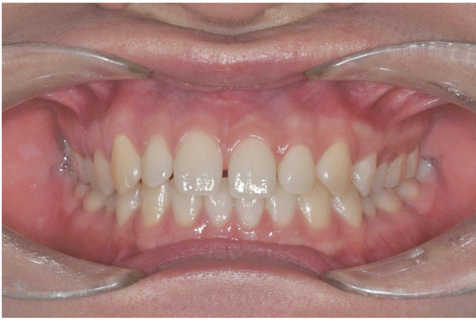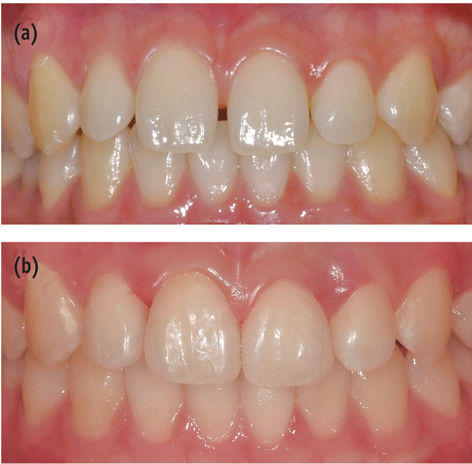Restor Dent Endod.
2012 Aug;37(3):165-169. 10.5395/rde.2012.37.3.165.
Diastema closure using direct bonding restorations combined with orthodontic treatment: a case report
- Affiliations
-
- 1Department of Conservative Dentistry, Kyungpook National University School of Dentistry, Daegu, Korea. wisekim@knu.ac.kr
- KMID: 1995657
- DOI: http://doi.org/10.5395/rde.2012.37.3.165
Abstract
- Closure of interdental spaces using proximal build-ups with resin composite is considered to be practical and conservative. However, a comprehensive approach combining two or more treatment modalities may be needed to improve esthetics. This case report describes the management of a patient with multiple diastemas, a peg-shaped lateral incisor and midline deviation in the maxillary anterior area. Direct resin bonding along with orthodontic movement of teeth allows space closure and midline correction, consequently, creating a better esthetic result.
Figure
Reference
-
1. Wolff D, Kraus T, Schach C, Pritsch M, Mente J, Staehle HJ, Ding P. Recontouring teeth and closing diastemas with direct composite buildups: a clinical evaluation of survival and quality parameters. J Dent. 2010. 38:1001–1009.
Article2. Lenhard M. Closing diastemas with resin composite restorations. Eur J Esthet Dent. 2008. 3:258–268.3. Kim YH, Cho YB. Diastema closure with direct composite: architectural gingival contouring. J Korean Acad Conserv Dent. 2011. 36:515–520.
Article4. Heymann HO, Hershey HG. Use of composite resin for restorative and orthodontic correction of anterior interdental spacing. J Prosthet Dent. 1985. 53:766–771.
Article5. Kuljic BL. Merging orthodontics and restorative dentistry: an integral part of esthetic dentistry. J Esthet Restor Dent. 2008. 20:155–163.
Article6. Zhang YF, Xiao L, Li J, Peng YR, Zhao Z. Young people's esthetic perception of dental midline deviation. Angle Orthod. 2010. 80:515–520.
Article7. Brisman AS. Esthetics: a comparison of dentist's and patient's concepts. J Am Dent Assoc. 1980. 100:345–352.
Article8. Lasseigne TP, Chiche G, Tokutomi H, Wiltz II CP, Mendez AJ. Managing space in the anterior dentition. Am J Esthet Dent. 2011. 1:138–157.9. Murchison DF, Roeters J, Vargas MA, Chan DCN. Summitt JB, Robbins JW, Hilton TJ, Schwartz RS, editors. Direct Anterior Restorations. Fundamentals of Operative Dentistry: A Contemporary Approach. 2006. 3rd ed. Chicago: Quintessence;274–279.10. Heymann HO. Roberson TM, Heymann HO, Swift EJ, editors. Additional Conservative Esthetic Procedures. Sturdevant's Art and Science of Operative Dentistry. 2006. 5th ed. St. Louis: Mosby;635.
Article11. Kim TW, Echarri P. Clear aligner: an efficient, esthetic, and comfortable option for an adult patient. World J Orthod. 2007. 8:13–18.
- Full Text Links
- Actions
-
Cited
- CITED
-
- Close
- Share
- Similar articles
-
- Clinical study on the relapse of diastema
- Orthodontic treatment using indirect bonding technique in periodontitis
- Diastema closure with direct composite: architectural gingival contouring
- Alterations of papilla dimensions after orthodontic closure of the maxillary midline diastema: a retrospective longitudinal study
- The shear bond strength of two adhesives bonded to composite resin and glass ionomer cement restorations







